The User Friendly Electrical Safety Guide For Business Owners

This guide covers the key steps to keep employees safe and avoid workplace dangers. It helps your business run safely and smoothly.
Key Takeaways
Understand local and national safety standards to ensure compliance
Invest in proper personal protective equipment (PPE) for electrical work
Prioritise regular safety training to keep employees up-to-date
Conduct thorough risk assessments and identify potential electrical hazards
Implement robust emergency response and first aid procedures
Understanding Electrical Safety Regulations and Compliance
Business owners need to understand electrical safety rules to keep their employees safe. In the UK, following safety standards is a must. It shows they care about their workers’ safety.
Local and National Safety Standards
The electrical regulations in the UK come from local and national rules. Business owners must know the specific rules in their area. They also need to follow national safety rules. Not following these compliance requirements can lead to big fines and legal trouble.
Legal Requirements for Business Owners
The Health and Safety at Work etc. Act 1974 makes it clear that UK business owners must keep their employees and the public safe. This includes making sure electrical systems are installed, maintained, and used correctly. Ignoring these rules can result in fines of up to £20,000 or more for serious cases.
Industry-Specific Guidelines
Certain industries, like construction or manufacturing, have extra electrical safety standards and compliance requirements.
Business owners must keep up with the latest rules for their industry.
Working with qualified electricians and safety experts can help understand and follow industry electrical regulations.
Regulation
Key Requirements
Penalties for Non-Compliance
Health and Safety at Work etc. Act 1974
Ensure the safety of employees and the public through proper electrical installations and maintenance
Up to £20,000 for summary convictions, unlimited fines for more serious offences
Electricity at Work Regulations 1989
Require businesses to prevent danger from electricity in the workplace
Up to £20,000 for summary convictions, unlimited fines for more serious offences
Construction (Design and Management) Regulations 2015
Specific electrical safety requirements for the construction industry
Up to £20,000 for summary convictions, unlimited fines for more serious offences
By focusing on following electrical regulations and electrical safety standards, business owners can keep their operations safe. They protect their workers and avoid the high costs of not following the rules.
Essential Personal Protective Equipment (PPE) for Electrical Work
Working with electricity can be dangerous, leading to shock, burns, and injuries. The right personal protective equipment (PPE) is key to keeping workers safe. Items like insulated gloves, shatterproof eye protection, flame-resistant clothing, and non-conductive footwear are crucial. They help reduce the risks of electrical hazards.
Types of Protective Gear
Workers doing electrical work need different types of PPE. This depends on the job they are doing. Here are some examples:
Insulated gloves to protect the hands from electric shock and burns
Voltage-rated tools to prevent accidental contact with live parts
Flame-resistant clothing to shield the body from arc flash hazards
Arc flash suits, including a face shield, to defend against intense heat and light
Safety shoes with non-conductive soles to prevent electric shocks
Dielectric overshoes or mats to insulate workers from the ground
Proper PPE Maintenance
Keeping electrical PPE in good condition is vital. Workers should check their gear before each use. They should look for any signs of wear, damage, or degradation. If the PPE looks damaged, it should be taken out of service and replaced.
It’s also important to store, clean, and follow the manufacturer’s guidelines. This ensures the PPE continues to protect workers effectively.
When to Replace Safety Equipment
Electrical PPE has a limited lifespan and needs to be replaced regularly. The exact time for replacement depends on the type of equipment, how often it’s used, and the conditions it’s in. Workers should replace their PPE if it shows signs of wear, damage, or when the manufacturer advises it.
Not replacing worn or damaged PPE can be dangerous. It can lead to serious injury or even death.
In the electrical industry, using and maintaining PPE correctly is not just a good idea. It’s the law. By providing the right PPE and ensuring it’s well-maintained, businesses can protect their employees from the dangers of electrical work.
Electrical Safety Guide: Training and Staff Development
Keeping a workplace safe is key for any business. Electrical safety is a big part of this. It’s vital to have electrical training and staff development to teach employees about safety.
Electrical accidents can cause serious harm, from minor burns to life-threatening injuries. The US Bureau of Labor Statistics (BLS) shows a rise in electrocution deaths at work. So, it’s crucial for all who work with electricity to get regular safety training.
Training should cover topics such as identifying exposed wires, using electrical equipment correctly, and avoiding electrical shocks.
Hands-on exercises, simulations, and interactive multimedia resources can reinforce learning and ensure employees retain critical safety knowledge.
Ongoing education and on-site work experience are crucial to increasing knowledge and demonstrating the company’s commitment to its employees’ wellbeing.
Good electrical safety training keeps workers safe and helps follow the law. Not training enough can lead to fines from bodies like the Occupational Safety and Health Administration (OSHA).
Investing in electrical training and staff development makes a workplace safer. It helps prevent accidents and keeps employees safe. Making electrical safety education a priority is essential for a safe work environment and business success.
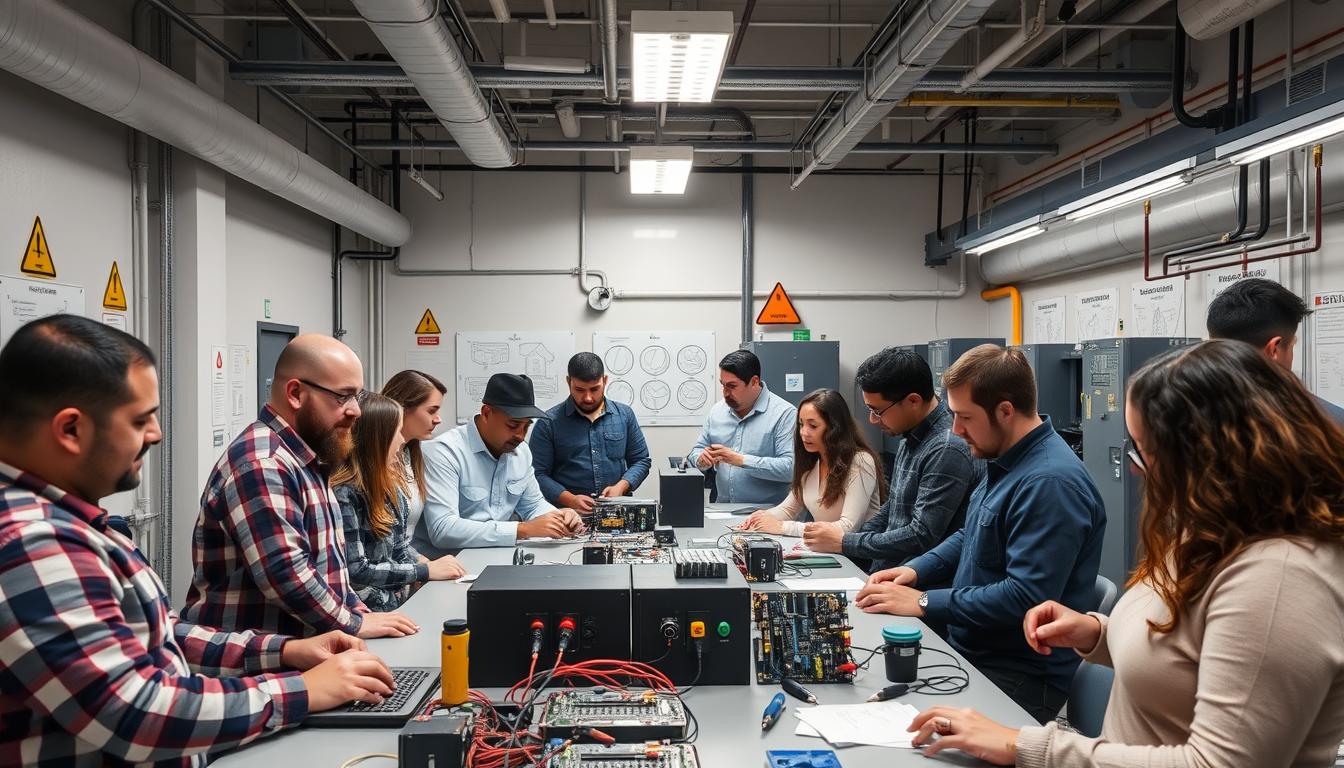
“Developing a culture of safety can lead to a safer work environment and help in the prevention of accidents beyond electrical hazards.”
Risk Assessment and Hazard Identification in the Workplace
Keeping the workplace safe is key for any business, especially with electrical safety. Regular checks and spotting hazards are vital. They help avoid electrical accidents, hazard identification, and ensure a safe risk assessment environment.
Common Electrical Hazards
Workplace electrical hazards include electric shock, arc flash, and short circuits. Overheating and poor grounding are also risks. These can cause serious injuries or death if not handled right.
Recent figures show electricity is a top cause of work injuries in the US. About 4,000 injuries and one death happen every day.
Prevention Strategies
De-energise electrical equipment before starting work
Use lockout and tag procedures to stop equipment from being turned back on during maintenance
Keep a safe distance from live parts to avoid shocks and arc flashes
Check electrical panels, circuits, and equipment often for damage or wear
Documentation Requirements
Keeping proper records is vital for meeting electrical safety standards. This includes clear labels on electrical panels and devices. It’s also important to document regular inspections and risk assessments.
Any problems found should be fixed quickly.
Hazard Identification
Risk Assessment
Control Measures
Spot potential electrical hazards like exposed live parts, damaged equipment, and poor grounding.
Check how likely and serious incidents could be, using a risk matrix to judge the risk level.
Put in place the right control measures, like isolating hazards, using personal protective equipment (PPE), and safe work procedures.
By doing regular electrical safety risk assessments and spotting hazards, businesses can reduce risks. This boosts worker morale and productivity. It also makes sure they follow the rules.
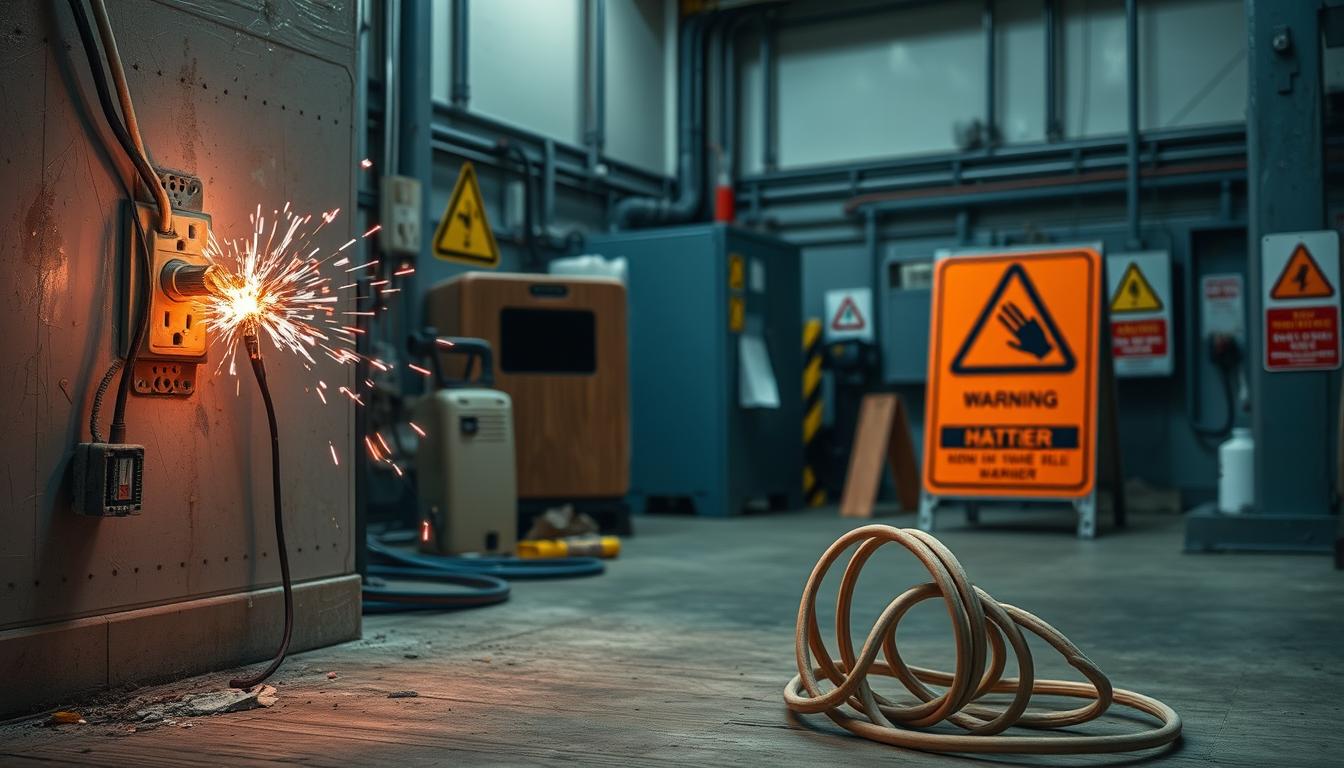
Emergency Response and First Aid Procedures
Electrical emergencies are very dangerous and can be life-threatening. It’s crucial for electricians and business owners to ensure their employees are trained in first aid. This includes getting CPR certification.
If there’s an electrical accident, the first thing to do is cut power to the area if you can. Don’t try to touch someone who’s in contact with electricity. Keep at least 20 feet away from high-voltage wires until the power is off.
Look out for signs of serious injury like severe burns, confusion, or trouble breathing. If someone’s heart stops, start CPR right away. This can save their life.
It’s important to have a first aid kit ready in vehicles and on job sites. This kit should have bandages, antiseptic, and burn treatments. It helps with minor injuries until medical help arrives.
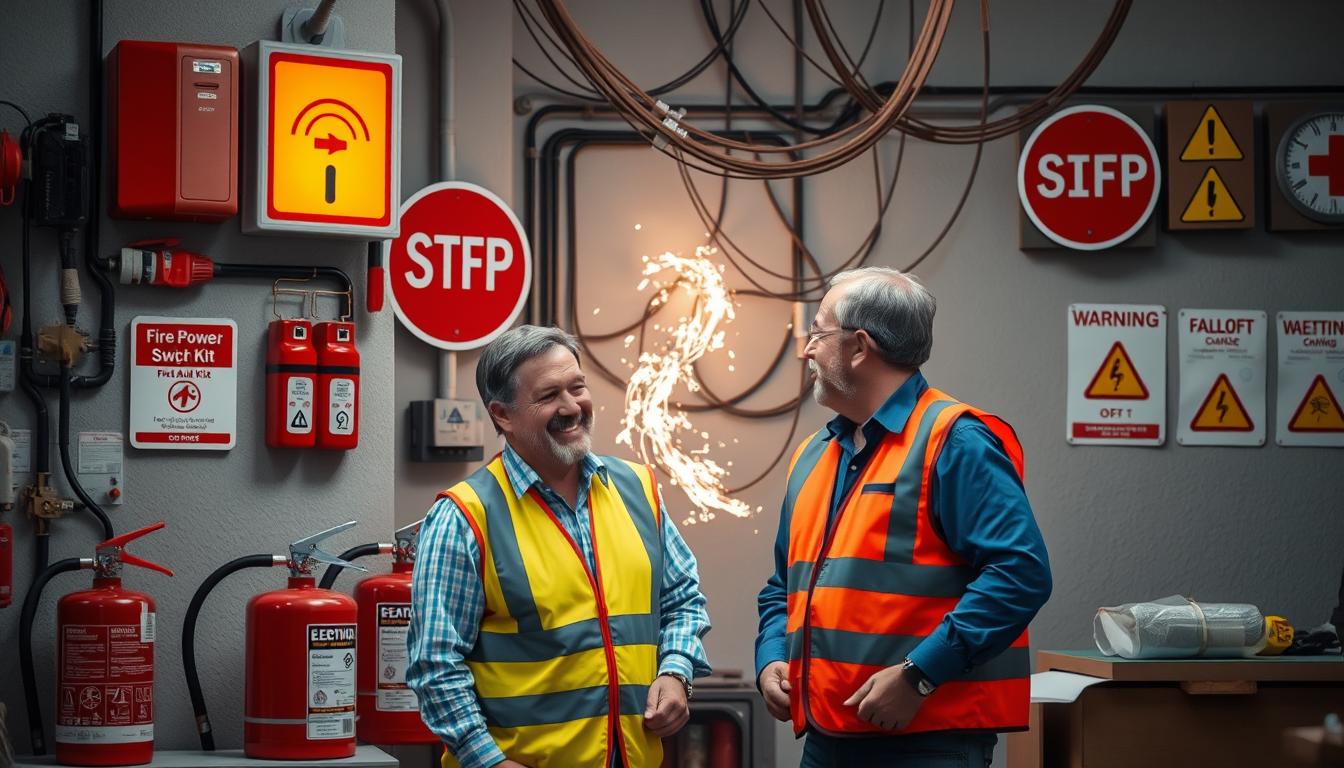
Electrical fires are another big risk. Businesses need a good emergency plan. This plan should tell you how to cut power, use a fire extinguisher, and call for help.
Putting electrical safety first is key to protecting employees. Regular training, first aid kits, and a clear plan are vital. They can make a big difference in emergencies.
Maintenance and Inspection Protocols
Keeping electrical systems safe and reliable is key for business owners. This part talks about the important maintenance and inspection steps to avoid electrical dangers. These steps include regular checks and keeping detailed records of equipment. They are the base of a good electrical safety plan.
Regular Testing Schedules
Following a strict testing schedule is vital for electrical safety. It means checking and testing all electrical gear often. This includes power lines, circuit breakers, and panels. It helps spot and fix problems early, reducing the risk of electrical inspections and keeping equipment safe.
Equipment Maintenance Records
Keeping accurate records is a big part of electrical safety. Businesses should keep detailed equipment maintenance logs. These logs should show when equipment was checked, fixed, or replaced. This helps spot trends and plan for future safety audits. It shows a business’s dedication to electrical safety and following rules.
Safety Audit Procedures
Regular safety audits are key to finding and fixing electrical dangers. These thorough checks should be done by experts. They look at the electrical system, find issues, and suggest fixes. A strong safety audit process helps tackle electrical safety problems and keeps everyone safe.
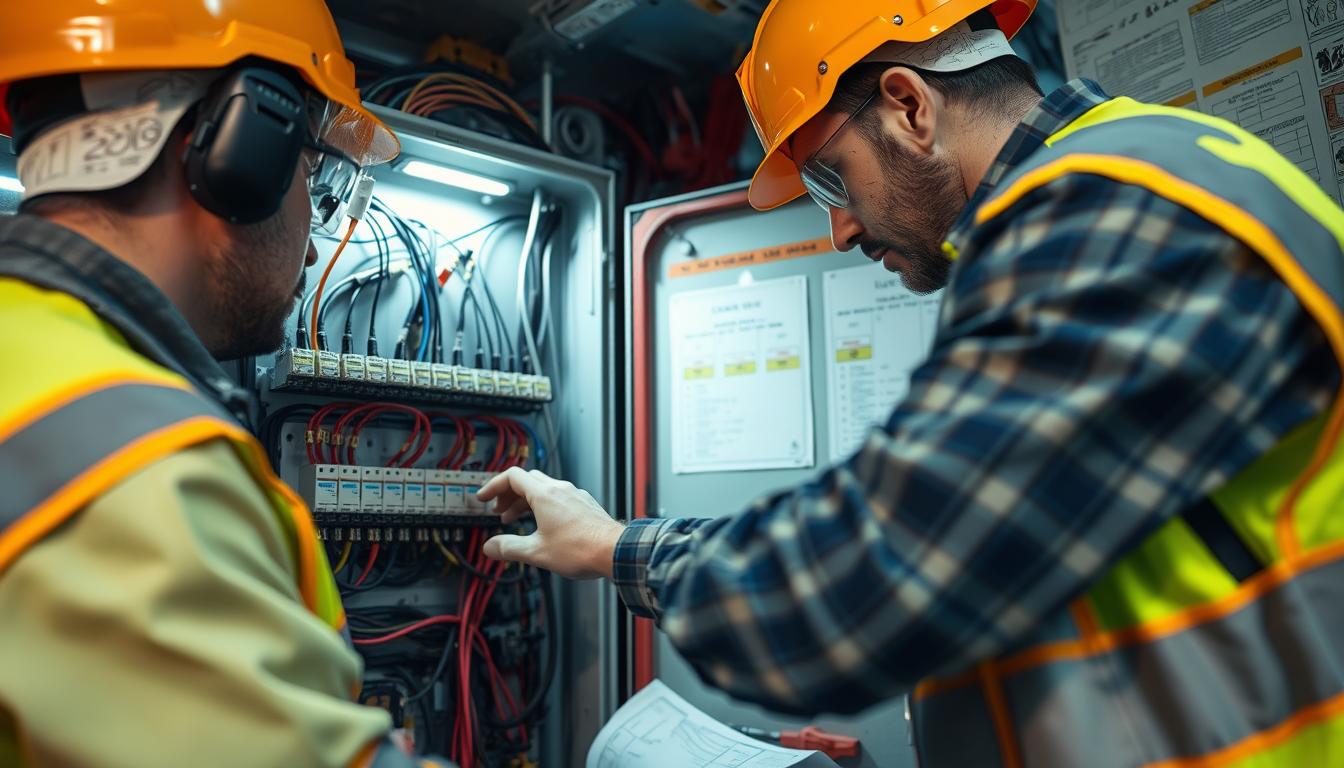
Keeping electrical systems safe and working well is a big job for business owners. By sticking to strict testing, keeping good records, and doing thorough safety checks, companies can lower electrical risks. This makes the workplace safer for everyone.
Weather-Related Electrical Safety Measures
Extreme weather is becoming more common, and electrical safety is key for businesses. Storms, heatwaves, and cold snaps can damage power systems and equipment. Knowing these risks and taking safety steps can protect staff, assets, and operations.
Weathering the Storm
Thunderstorms bring lightning dangers. Move to a low spot and crouch down to avoid being hit. Stay away from metal and water, as they can conduct electricity. Also, watch for tingling or standing hair, signs of lightning.
Downed power lines are very dangerous. Keep at least 10 feet away and don’t touch anything near the line. Shuffle your feet together to avoid electric shock when moving away.
Flood Precautions
Avoid flooded areas, as the water may be live and dangerous.
Check any water-damaged appliances before using them. Get a professional to inspect and test them.
Throw away any electrical items that got wet. Replace them to stay safe after a flood.
Keeping Cool and Warm
Extreme temperatures can harm electrical systems. In heatwaves, don’t use wet appliances until checked by a pro. Use portable generators safely, installed by a licensed electrician.
In winter, safety is just as important. Unplug space heaters when not in use and keep them away from flammable things. Surge protectors can guard against power surges from lightning or other weather issues.
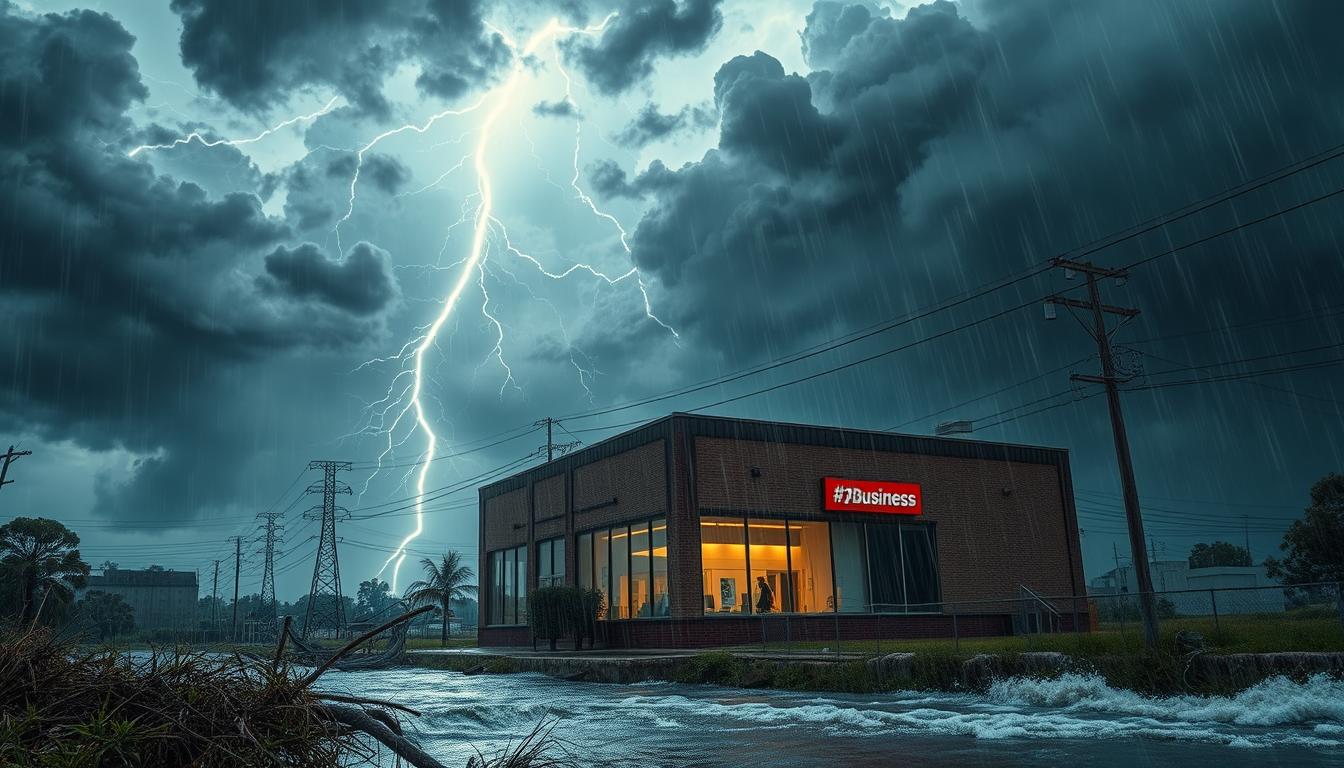
Stay alert and follow these electrical safety tips for weather. This can protect your business, employees, and profits. Good training, equipment, and emergency plans are crucial for facing weather challenges.
Safe Work Practices and Procedures
Keeping the workplace safe from electrical hazards is key to protecting staff and keeping business running smoothly. It’s vital to follow safe work practices and procedures. This section focuses on three main areas: lockout/tagout, working in tight spaces, and keeping tools and equipment safe.
Lockout/Tagout Procedures
Lockout/tagout rules make sure equipment is turned off before starting work. Only trained workers can follow these steps to avoid accidents. It’s important to lock down and tag the energy source to keep everyone safe.
Working in Confined Spaces
Working in tight spots, like underground vaults or small utility rooms, is risky. Safety steps include wearing the right gear, having good air, and clear communication. Workers need special training to handle these dangers and spot potential risks.
Tools and Equipment Safety
Using insulated tools and well-maintained equipment is crucial for safety. Workers should know how to handle and store tools right. Regular checks and upkeep keep all electrical gear in top shape, reducing the risk of accidents.
Keeping work areas tidy is also vital for safety. Messy spaces can lead to accidents. A clean, organised workspace not only keeps everyone safe but also shows a good image of the company.
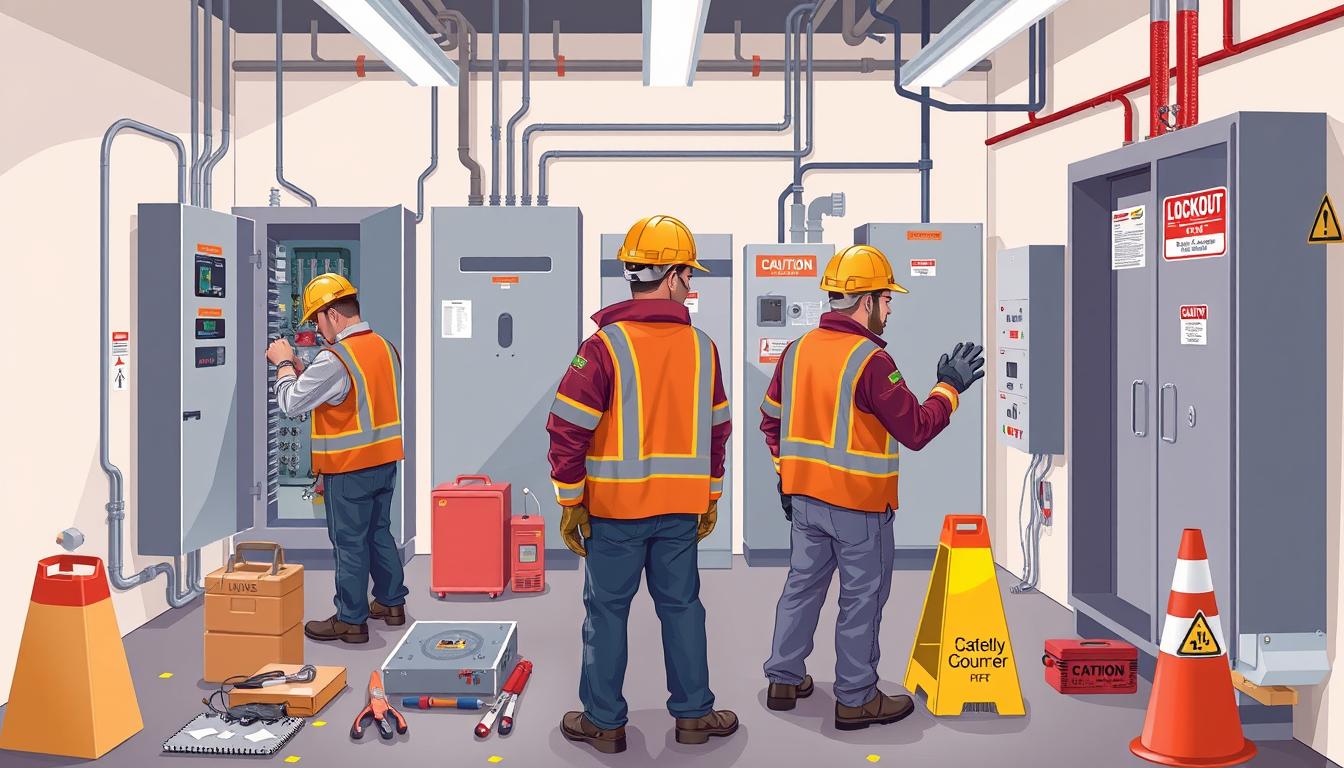
“Electrical safety is not just a box to be ticked, but a mindset that must be embedded in every aspect of our work. By prioritising safe practices and procedures, we can protect our employees and ensure the continuity of our operations.”
Creating a Safety-First Culture in Your Business
Creating a safety-first culture is key for electrical businesses. It ensures the well-being of employees and clients. By making safety a core value, companies can create a space for proactive risk management and safety engagement.
Regular safety talks and incentive programmes help. Keeping work vehicles clean and stocked also promotes a safety-first mindset. Valuing employees and investing in their safety boosts productivity and job satisfaction.
Safety should be a top priority in all customer interactions. Educating clients about electrical hazards shows commitment to safety. This sets electrical companies apart as trusted leaders in their field.
FAQ
What are the essential practices to protect employees and prevent workplace electrical hazards?
The guide stresses the importance of understanding safety codes. It also talks about wearing proper protective gear and maintaining equipment. Turning off mains power, installing warning signs, and working within one’s qualifications are key. Being prepared for emergencies is also crucial.
What are the key aspects of electrical safety regulations and compliance that business owners need to know?
This section covers local and national safety standards. It talks about legal requirements for business owners and industry-specific guidelines. Knowing and understanding safety codes in your area is vital. It’s also important to work within one’s qualifications and refer jobs to more experienced licensed electricians.
What types of personal protective equipment (PPE) are essential for electrical work, and how should it be maintained?
This section outlines various types of protective gear. This includes hard hats, electrical gloves, shatter-proof eye protection, and non-conductive footwear. It stresses the importance of proper PPE maintenance. PPE safeguards employees from electrical shocks, burns, and other injuries.
Why is ongoing electrical safety training and staff development crucial for businesses?
This section highlights that safety training should be ongoing. It should refresh employees’ knowledge of best practices. It’s important for all employees working with electricity to be well-versed in safety procedures. Continued education and on-site work experience increase knowledge and show the company values its employees.
What are the key steps for identifying and addressing electrical hazards in the workplace?
This section outlines common electrical hazards. It discusses prevention strategies, such as de-energising electrical equipment. It also covers the importance of proper labelling and organisation of electrical panels and devices.
How should businesses prepare for and respond to electrical emergencies?
This section stresses the importance of being prepared for emergencies. It suggests electricians consider taking first aid courses and becoming CPR certified. It also covers the need for an emergency response plan and a first aid kit in vehicles.
What are the key maintenance and inspection protocols for ensuring electrical safety in the workplace?
This section highlights the need for regular testing schedules. It stresses the importance of keeping detailed equipment maintenance records. Regular safety audits are also crucial to identify potential electrical hazards.
What are the specific safety considerations for working with electricity in extreme weather conditions?
This section covers winter and summer safety tips for electricians. It includes dressing properly, staying hydrated, and taking breaks to prevent cold stress or heat stroke. It also mentions the increased likelihood of power outages and electrical problems during extreme weather.
What are the essential safe work practices and procedures for electrical work?
This section covers lockout/tagout procedures and working in confined spaces. It stresses the importance of using insulated tools and handling equipment to protect against electric shock. Regular tool inventory and maintenance, as well as keeping work areas clean and organised, are also important.
How can businesses create a safety-first culture to prioritise electrical safety?
This section stresses that safety should be a top priority in every aspect of the business. It discusses strategies for engaging employees in safety practices, such as regular safety talks and incentives. Valuing employees and investing in their safety and development is also crucial. Prioritising safety in customer communication is important too.





